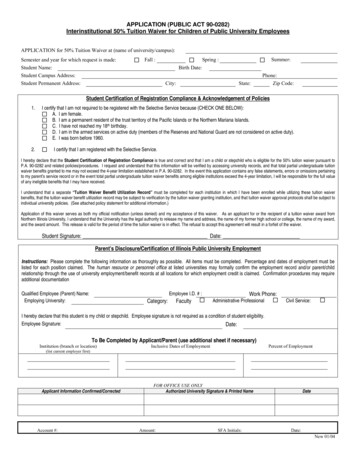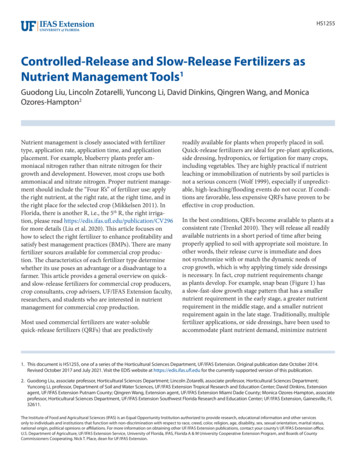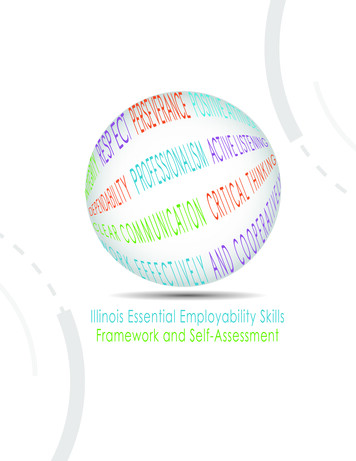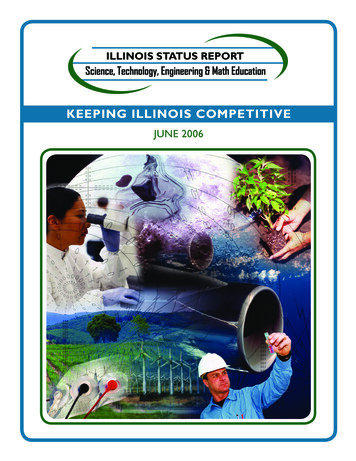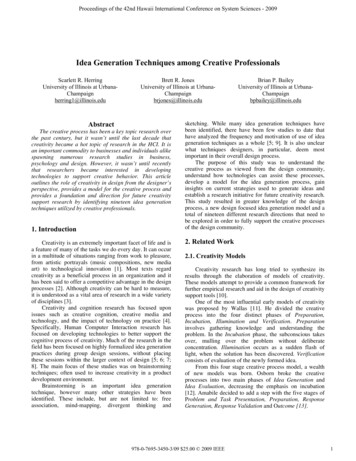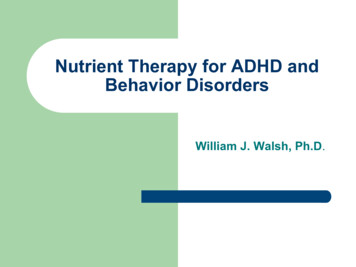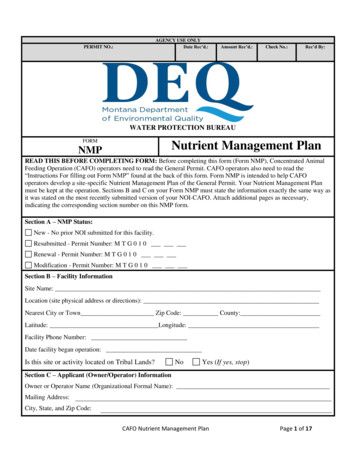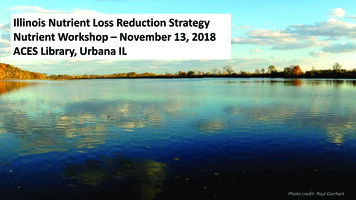
Transcription
Illinois Nutrient Loss Reduction StrategyNutrient Workshop – November 13, 2018ACES Library, Urbana ILPhoto credit: Paul Gierhart
TIMESESSIONROOM10:00-11:00 amOPEN PLENARY SESSIONWelcome George CzaparSERA-46 Update Amanda GumbertMonsanto Room11:00-NoonBREAKOUT SESSIONSAgriculture Water Quality Partnership ForumUrban Stormwater Working GroupMonsanto RoomSims Room (first floor)Noon-1:30 pmLUNCHOn own1:30-4:00 pmPOLICY WORKING GROUPMonsanto Room4:30-6:00 pmRESEARCH SHOWCASEHeritage Room (first floor)@IllinoisNLRS #NLRS2018
Illinois Nutrient Loss ReductionStrategy WorkshopGeorge Czapargfc@illinois.edu
NLRS is a science-based partnership effortCollaboration with stakeholdersExpanding education and outreachHelping identify research needsHelping leverage additional funding
Illinois legislature: Food and Agriculture Act, 1995
Strategic Research Initiatives - 1998Food SafetyInformation Systems and TechnologyRural Community DevelopmentSwine Odor and Waste ManagementWater Quality
How to develop nutrient standards that areprotective of water quality, but are alsorealistic and achievable?
C-FARStrategic Research InitiativeWater Quality
C-FAR work helped secure additional USDA projects
Illinois Corn Growers AssociationIllinois Farm BureauIllinois Fertilizer and Chemical AssociationIllinois Pork Producers AssociationIllinois Soybean Checkoff BoardSyngenta Crop ProtectionUniversity of Illinois ExtensionAssist and encourage adoption of best management practices (BMPs) to protect andimprove water quality in Illinois
environment
Additional support from Illinois EPAIllinois Nutrient Loss Reduction Implementation:Coordination of Watershed Scale Programs andDevelopment of Agricultural Water Quality TeamAugust 1, 2007 through June 30, 2022
Agricultural Water Quality TeamLaura ChristiansonJonathan CoppessPaul DavidsonSuzanne BissonnetteCrop SciencesAgriculture and ConsumerEconomicsAgricultural and BiologicalEngineeringAgriculture and NaturalResourcesMaria VillamilCameron PittelkowReid ChristiansonGeorge CzaparCrop SciencesCrop SciencesCrop SciencesCrop Sciences
NLRS is a science-based partnership effortCollaboration with stakeholdersExpanding education and outreachHelping identify research needsHelping leverage additional funding
SERA-46Land Grant Universities WorkingCollaboratively with the Hypoxia Task ForceAmanda Gumbert, University of KentuckyBeth Baker, Mississippi State University, Co-Chair
2017Source: ?y 20172017: 22,720 km2 (8,776 mi2/5.6m ac); largest size measured to date since thestandardized mapping cruises began in July 1985. Source: Nancy Rabalais (LUMCON)
2018Source: https://gulfhypoxia.net/2018: 2,720 sq. miles (1.7m acres); slightly larger than state of Delaware, well below projectedestimate of 6,570 sq. miles.
Too Much of a Good ThingImage: s.htmlImage: https://emojiisland.com/products/poop-emoji-icon
Science-based GoalCoastal GoalBy 2035, reduce 5-year running average sizeof the Gulf hypoxic zone to 5,000 km2From Nancy Rabalais (LSU/LUMCON)Interim Target20% reduction of nitrogen andphosphorus loading by 2025
Role of Land Grant Universities (LGUs) in U.S.TeachingMorrill Act, 1862Teach such branches oflearning as are related toagriculture and themechanic arts.ResearchHatch Act, 1887Provide federal funds tostate land grant colleges tocreate agricultural researchfacilities.ExtensionSmith Lever Act, 1914Provide education to adultsoff-campus that is relevant,understandable andpractical.
What is SERA-46? Southern Extension and Research Activities committee number 46. Formal USDA National Institute of Food and Agriculture (NIFA) andland-grant university funded committee designed to promotemultistate, research and extension activities. Created to operationalize a non-funded Cooperative Agreementbetween the Hypoxia Task Force and land-grant university Extensionand Experiment Stations in the North Central and Southern Regionsof the United States
USDA-NIFA coordinatesmultistate efforts via regionalcommittees12 LGUs in MississippiRiver BasinStrong linkage/coordinationwith Hypoxia Task Force
LGU Expertise in Addressing Gulf of Mexico ocialScientistsEconomists
SERA-46 GoalPromote effective implementation ofscience-based approaches to nutrientmanagement/conservation that reducenutrient losses to the environment.
Priorities for Collaborative WorkDeveloped May 2015Revised September 2017Three Focus Areas1. Strengthening Networks2. Conservation SystemsResearch and Outreach3. Monitoring and Tracking ofProgress
ProgressConservation Systems Research and Outreach #1 - Assist in the optimization ofcover crop practice performance.Photo courtesy Mississippi State University
ProgressConservation Systems Research and Outreach #2Translate science in tile drained areas into accessibleinformation for states to adopt into policies to addressnutrient use and movement, particularly with corn and N.
ProgressConservation Systems Research and Outreach #4 Work in partnership with American Society ofAgronomy’s Certified Crop Advisor (CCA) program. Collaboration with state CCA boards to updateperformance objectives to include hypoxia Providing training opportunities in Soil and WaterConservation competency area that includes statenutrient-related regulations and strategies forreducing nutrient losses
ProgressMonitoring and Tracking Progress #3 – Using Social Indicators and Civic Engagementto Advance Nutrient Reduction EffortsDelivery Civic Engagement workshop May 2018 Established an information hub: Human Dimension in Waterhttps://h2o.ssrc.msstate.edu/Rogers’ Innovation-Decision Process ModelImage: ovation-decision-process-in.html
ProgressConservation Systems Research and Outreach #3 – Create a network ofwatershed practitioners and farmer leaders to strengthen theeffectiveness of nutrient management strategies.Photo courtesy University of Kentucky
Watershed Leadership Summit detail/national/programs/farmbill/rcpp/?cid stelprdb1254130
Watershed Leadership Summit 2018 Needs Identified Network of watershed projectsuccesses Watershed coordinatorcertification program/professionaldevelopment effort More precision tools for targetingconservation practiceimplementation More communication Outcome Network of watershed leaders
Watershed Leadership Summit 2019 Long Beach, MSImage: 06443
Farmer and Farm AdvisorLeadership Needs AssessmentRebecca Power (University of Wisconsin) and Jamie Benning(Iowa State University)
Purpose Characterize farmer and farm advisor leadership in watershed management Identify successful methodologies for fostering farmer-led watershed initiatives List existing leadership training programs for watershed practitioners, farmers and farmadvisors Identify geographical, content and pedagogical gaps in existing educational programsMethods Literature Review Program Scan Interviews
Farmer Watershed LeadershipPeer-to-peerDecision-making Recruiting otherfarmers BMPdemonstrations MentoringConsultationWatershedLeadership Serving onadvisory groups Assistingwatershed staff Informing goalsetting Formal leadershiprole Defining goals andstrategies Directing resourcedistributionLevel of Engagement
General Observations Farmers and farm advisor leadership is critical for watershed managementFarmer leadership in watershed initiatives is not newConcept is not yet widespreadThere are currently no learning networks dedicated to farmer-led watershedinitiatives A platform or forum for sharing experiences and ideas may be beneficial tofarmers and supporting organizations Some level of financial, technical, material, or educational support will berequired for most farmer-led watershed projects
Continued Work MARB Nonpoint Sources NutrientReduction Measurement Framework Facilitate dialogue between SERA-46members and state HTF members Cross-MARB communication ofscience directly to state agencies fortranslation into their nutrientreduction policies and programs
Future Efforts and Needs Expand farmer-led watershedleadership efforts. Expand economics shared priorityaround on-farm economic tools,costs, and benefits. Expand research and education onmultifunctional agriculturallandscapes that provide a broadsuite of societal and ecosystemservices.
FundingFuture WaltonFamilyFoundationUS EPA CompetitiveFundsUSDA-NIFA Funds(Matching State Funds)
Valuable Collaborations State and Federal agencies represented by Hypoxia Task Forcemembership Direct farmer and farm advisor interaction Extension audiences State Departments of Agriculture Some states have records of success Iowa State University a resource for science, research, technology, on-farmpractices Other multi-state committees SERA-17, NC-1190, etc.
For More ships
Thank You!
BREAKOUT SESSIONSAWQPFMonsanto Room(stay here)USWGSims Room(upstairs)
Formal USDA National Institute of Food and Agriculture (NIFA) and land-grant university funded committee designed to promote multistate, research and extension activities. Created to operationalize a non- funded Cooperative Agreement between the Hypoxia Task Force and land -grant university Extension
